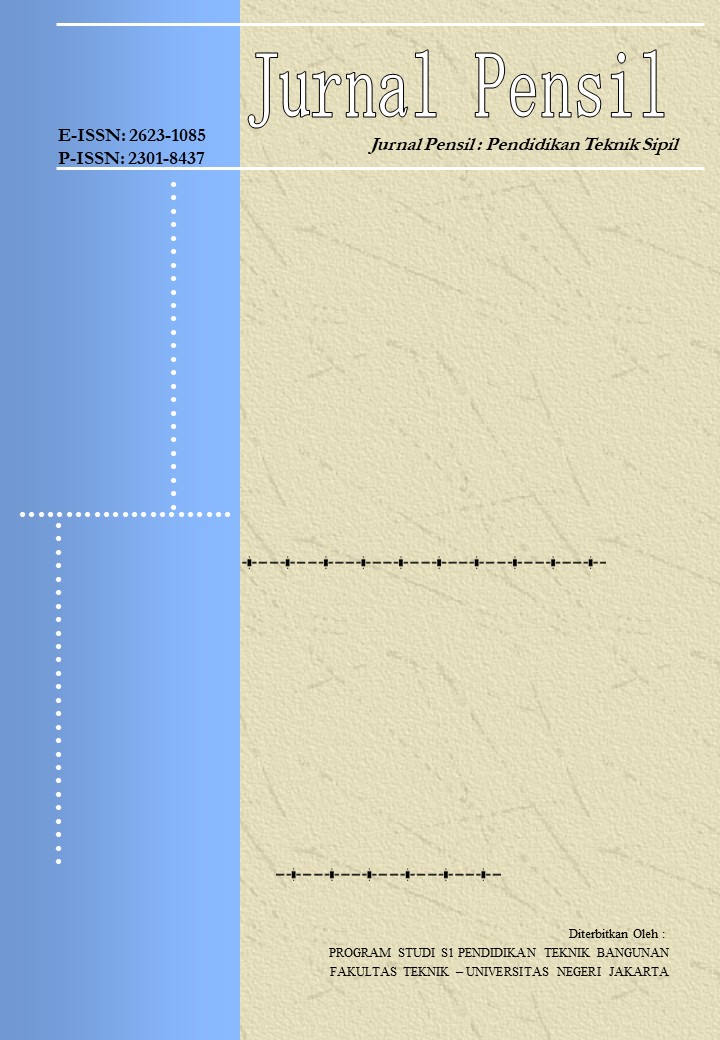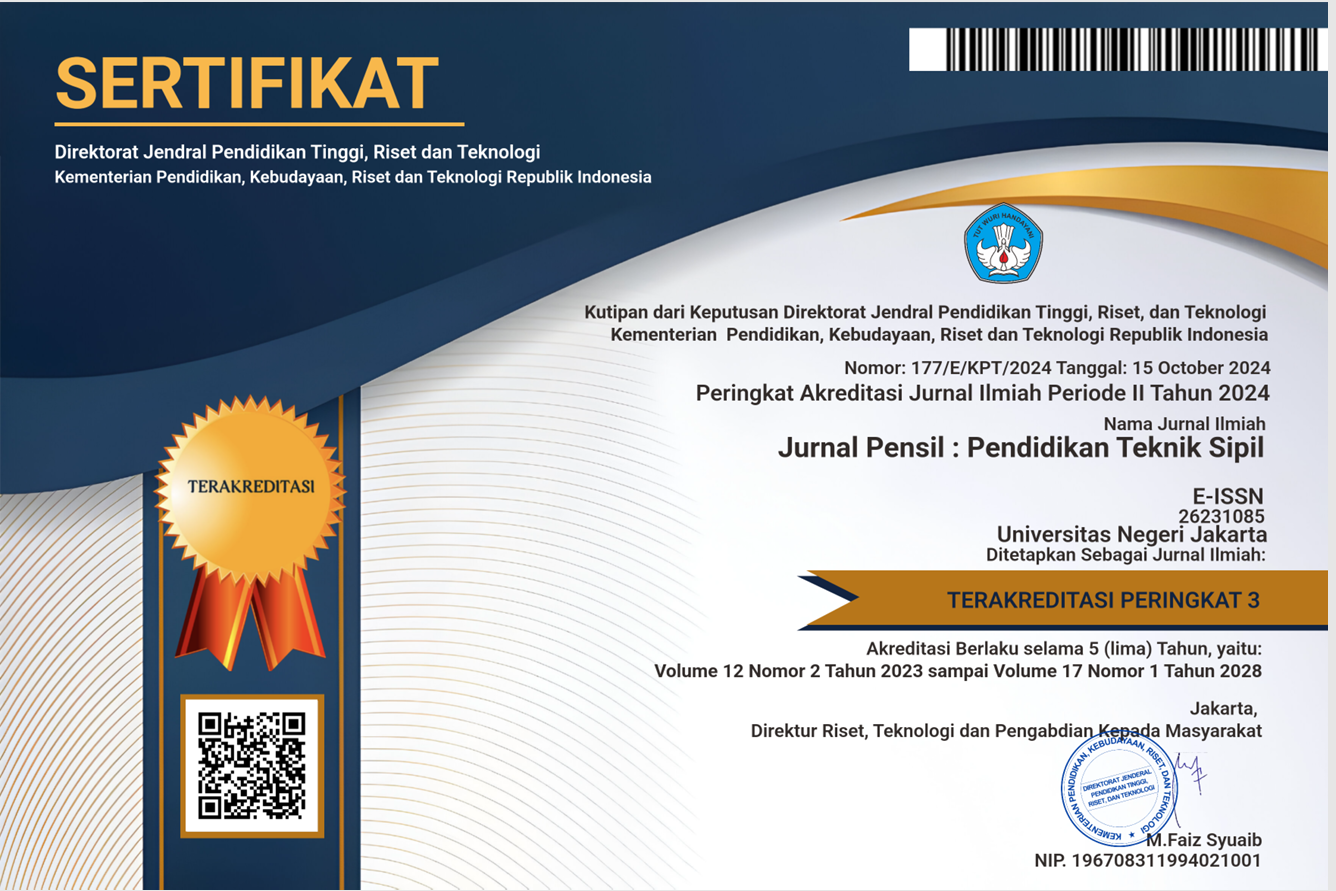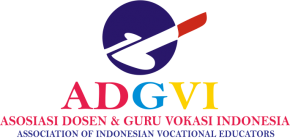STUDENTS’ PERCEPTIONS ON THE USE OF E-MODULES IN BUILDING ENGINEERING EDUCATION STUDY PROGRAM
DOI:
https://doi.org/10.21009/jpensil.v11i3.28437Keywords:
Perception, E-Module, Concrete Stone Practice CourseAbstract
This study aims to examine student perceptions of the use of e-module teaching materials in the Concrete Stone Practice course, Building Engineering Education study program, Faculty of Engineering, State University of Jakarta. This research is descriptive-quantitative research, with the data collection instrument in the form of a questionnaire. There are four indicators that are measured in knowing students' perceptions of the use of e-module teaching materials, namely the presentation of the material, language, graphics, and usefulness. The research population is Building Engineering Education students batch 2021 who take the Concrete Stone Practice course in the even semester of the 2021/2022 academic year with a research sample of 74 students. The results showed that students' perceptions of the use of the Concrete Concrete Practice e-module as a whole obtained an average of 86.39% in the very good category. This can be seen from the majority of students' perceptions showing that they agree and strongly agree with the presentation of the material, language, graphics, and benefits contained in the Concrete Stone Practice e-module that can help in the learning process. There is also supporting data, which is student score data during the learning process for the Concrete Stone Practice course, where the overall average score of 81.35 is included in the good category. Based on these results, it indicates that the concrete stone practice e-module can be used as an excellent alternative to help the student learning process in the Concrete Stone Practice course in the Building Engineering Education study program, State University of Jakarta.
References
Algahtani, H., Shirah, B., Subahi, A., Aldarmahi, A., Ahmed, S. N., & Khan, M. A. (2020). Perception of students about E-learning: a single-center experience from Saudi Arabia. Dr. Sulaiman Al Habib Medical Journal, 2(2), 65–71.
Arends, R. I. (2008). Learning to Teach. Pustaka Pelajar.
Asrial, S., Kurniawan, D. A., Chan, F., Septianingsih, R., & Perdana, R. (2019). Multimedia innovation 4.0 in education: E-modul ethnoconstructivism. Universal Journal of Educational Research, 7(10), 2098–2107.
Aydin, A., & Aytekin, C. (2018). Teaching Materials Development and Meeting the Needs of the Subject: A Sample Application. International Education Studies, 11(8), 27–38.
Dzakwan, N., Murtinugraha, R. E., & Arthur, R. (2021). The Effectiveness of Using E-Modules in Statistics Courses in the Building Engineering Education Study Program, Faculty of Engineering, State University of Jakarta. Risenology, 8(2), 29–33.
Elvarita, A., Iriani, T., & Handoyo, S. S. (2020). Pengembangan Bahan Ajar Mekanika Tanah Berbasis E-Modul Pada Program Studi Pendidikan Teknik Bangunan, Universitas Negeri Jakarta. Jurnal PenSil, 9(1), 1–7.
Hafsah, N. R. J., Rohendi, D., & Purnawan. (2016). Application of Electronic Module Learning Media to Improve Student Learning Outcomes in Mechanical Technology Subjects. Journal of Mechanical Engineering, 03(01), 106.
Hasanah, U., Dewi, R. S., & Ratnaningsih, S. (2020). Effectiveness of digital teaching materials based on google classroom to improve digital literacy competencies during the covid-19 pandemic period. 2020 6th International Conference on Education and Technology (Icet), 59–63.
Hasibuan, S. R., & Andromeda. (2021). The Effectiveness of Using E-Module Colloidal System Based on Guided Inquiry Integrated Virtual Laboratory on Learning Outcomes of Class XI Students of SMAS Nurul ’ Ilmi. Research Realm:Journal of Multidiciplinary Research and Development, 3(2), 7–12.
Helmi, S. (2017). Kewirausahaan (Issue January 2008).
Indra, M. R. I., & Saleh, R. (2021). Pengembangan E-Module Praktik Batu Beton Di Program Studi Pendidikan Teknik Bangunan Unj. Jurnal PenSil, 10(1), 41–46. https://doi.org/10.21009/jpensil.v10i1.17781
Indra, M. R. I., Saleh, R., & Iriani, T. (2021). Pengembangan E-Module Praktik Batu Beton Di Program Studi Pendidikan Teknik Bangunan UNJ. Jurnal PenSil, 10(1), 41–46. https://doi.org/https://doi.org/10.21009/jpensil.v10i1.17781
Pembatasan activity Di Kampus Bagi Dosen, Tenaga Kependidikan Dan Mahasiswa Di Lingkungan Universitas Negeri Jakarta Selama Masa Pandemi Covid-19 Varian Omicron, (2022).
Khoir, H. M., Murtinugraha, R. E., & Musalamah., S. (2020). Development of Moodle-Based E-Learning Learning Media in Research Methodology Courses. Journal PenSil, 9(1), 54–60. https://doi.org/https://doi.org/10.21009/jpensil.v9i1.13453
Laili, I., Ganefri, & Usmeldi. (2019). Efektivitas Pengembangan E-Modul Project Based Learning Pada Mata Pelajaran Instalasi. Jurnal Imiah Pendidikan Dan Pembelajaran, 3, 308.
Lastari, H. D., Murtinugraha, R. E., & Arthur, R. (2021). The Development Of E-Module Statistic Course In Building Engineering Education Study Program. Jurnal Mahasiswa Parentas, 7(1), 10–14. https://doi.org/https://doi.org/10.37304/parentas.v7i1.2478
Mawardi, G., Iriani, T., & Daryati. (2019). Pengembangan Media Pembelajaran Berbasis Multimedia Pada Mata Kuliah Kompetensi Pembelajaran Pokok Materi Keterampilan Dasar Mengajar. Jurnal Pendidikan Teknik Sipil, 8(1), 24–30.
Misbah, M., Khairunnisa, Y., Amrita, P. D., Dewantara, D., Mahtari, S., Syahidi, K., Muhammad, N., Prahani, B. K., & Deta, U. A. (2021). The effectiveness of introduction to nuclear physics e-module as a teaching material during covid-19 pandemic. Journal of Physics: Conference Series, 1760(1), 12052.
Murtinugraha, R. E., & Ramadan, M. A. (2020). Pengembangan E-Modul Mata Kuliah Statistika Di Program Studi Pendidikan Teknik Bcollateral, Universitas Negeri Jakarta. BALANGA: Journal of Technological and Vocational Education, 8(2), 70–74. https://doi.org/https://doi.org/10.37304/balanga.v8i2.1908
Nartiningrum, N., & Nugroho, A. (2021). English teachers’ perspectives on challenges, suggestions, and materials of online teaching amidst the global pandemic. IJEE (Indonesian Journal of English Education), 8(1), 101–119.
Nur Jannah, I., Hariyanti, D. P. D., & Prasetyo, S. A. (2020). The Effectiveness of Multimedia Use in Science Learning in Elementary Schools. Elementary School Scientific Journal, 4(1), 54–59. https://doi.org/https://doi.org/10.23887/jisd.v4i1.24135
Nurdyansyah, & Mutala’liah, N. (2015). Development of Teaching Materials for Natural Science Modules for Grade IV Elementary School Students. 41(20), 1–15.
Prasetiyowati, Y., & Tandyonomanu, D. (2015). Pengembangan Modul Elektronik Pada Mata Pelajaran Animasi 3 Dimensi Materi Pokok Pemodelan Objek 3D Kelas XI Multimedia untuk Meningkatkan Hasil Belajar Di SMK Negeri 1 Magetan. Student Journal of Educational Technology, 6(2).
Purnamasari, N., Siswanto, S., & Malik, S. (2020). E-module as an emergency-innovated learning source during the Covid-19 outbreak. Psychology, Evaluation, and Technology in Educational Research, 3(1), 1–8.
Puspitasari, A. D. (2019). Application of Physics Learning Media Using Printed Modules and Electronic Modules in High School Students. Journal of Physics Education, 7(1), 17–25.
Ramadan, M. A., Handoyo, S. S., & Alfarisi, M. M. (2020). Development of Basic Physics Teaching Materials Based on E-Modules in Building Engineering Education, State University of Jakarta. Journal of Civil Engineering Education, 2(2), 117–123. https://doi.org/https://doi.org/10.21831/jpts.v2i2.36346
Ramdani, A., Jufri, A. W., Gunawan, G., Fahrurrozi, M., & Yustiqvar, M. (2021). Analysis of Students’ Critical Thinking Skills in terms of Gender Using Science Teaching Materials Based on The 5E Learning Cycle Integrated with Local Wisdom. Jurnal Pendidikan IPA Indonesia, 10(2), 187–199.
Peraturan President Republik Indonesia Nomor 8 Tahun 2012, (2012).
Rini, T. A., Maningtyas, R. D. T., & Cahyanto, B. (2020). The Effectiveness of E-Module Through Metacognitive Construction in Blended Learning System. 2020 6th International Conference on Education and Technology (ICET), 1–6.
Samiasih, R., Sulton, & Praherdhiono, H. (2017). Development of E-Module subjects of natural sciences the subject of interaction of living beings with their environment. Edcomtech, 2(2), 119–124.
Serevina, V., Nugroho, D. A., & Lipikuni, H. F. (2022). IMPROVING THE QUALITY OF EDUCATION THROUGH EFFECTIVENESS OF E-MODULE BASED ON ANDROID FOR IMPROVING THE CRITICAL THINKING SKILLS OF STUDENTS IN PANDEMIC ERA. MOJEM: Malaysian Online Journal of Educational Management, 10(1), 1–20.
Slameto. (2010). Learning and the Factors That Influence It. Rineka Cipta.
Sugiyono. (2019). Metodologi Penelitian Pendidikan: Pendekatan Kuantitatif, Kualitatif, dan R&D. Alfabeta.
Suharsimi, A. (2006). Prosedur penelitian suatu pendekatan praktik. Jakarta: Rineka Cipta, 120–123.
Susilana, R., & Riyana, C. (2008). Media pembelajaran: hakikat, pengembangan, pemanfaatan, dan penilaian. CV. Wacana Prima.
Tampubolon, M. A. W., Arthur, R., & Daryati, D. (2017). Pengembangan E-Module Konstruksi Bangunan pada Kompetensi Dasar Menerapkan Spesifikasi dan Karteristik Kayu. Jurnal PenSil, 6(2), 8. https://doi.org/10.21009/jpensil.v6i2.7241
Walgito, B. (2010). Introduction to General Psychology. C.V Andi.
Wartini, ., Sugiatno, & Idjudin, R. (2015). Media Pembelajaran Powerpoint Untuk Meningkatkan Kemampuan Penalaran Matematis Siswa Sekolah Menengah Pertama. Jurnal Pendidikan Dan Pembelajaran, 4(11), 1–15. http://jurnal.untan.ac.id/index.php/jpdpb/article/view/12223
Wijayadi, A. W., & Putra, E. bagus N. (2019). Akrim. (2018). Media Learning in Digital Era. 231(Amca), 458–460. https://doi.org/10.2991/amca-18.2018.127 Arends, R. I. (2008). Learning To Teach Learning to Teach. Pustaka Pelajar. Arikunto, S. (2010). Research Procedures A Practical Approach. Rhineka C. Zarah’s Journal, 7(2), 57–61. https://doi.org/https://doi.org/10.31629/zarah.v7i2.1455
Yunika, E., Iriani, T., & Saleh, R. (2020). Pengembangan Media Video Tutorial Berbasis Animasi 4D Untuk Kuliah Praktik Batu Beton. SNITT-Balikpapan State Polytechnic, 299–306. https://doi.org/https://jurnal.poltekba.ac.id/index.php/prosiding/article/view/1035/639











.png)
.png)
1.png)

